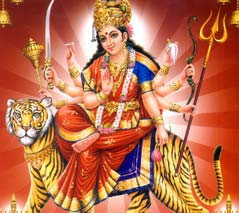
Hindu Festivals - Vijaya Dashami Rama destroyed Ravana on this day and hence it is celebrated as the day of victory. Rama invoked the blessings of the divine mother, Goddess Durga, before actually going out to battle. In the Kulu valley in Himachal Pradesh, the hill-folk celebrate Dussehra with a grand mass ceremony wherein village deities are taken out in elaborate processions. The Dussehra of Mysore is also quite famous where caparisoned elephants lead a colourful procession through the gaily-decorated streets of the city. One of the significant Hindu festivals it is celebrated with much joie de vivre in the entire country. Brilliantly decorated tableaux and processions depicting various facets of Rama's life are taken out and scenes from his life enacted out in a popular form of drama called Ramlila. On Vijayadashmi day, colossal effigies of Ravana, his brother Kumbhkarna and son Meghnath are burnt in vast open spaces by Rama (usually the actor who plays Rama in Ramlila). His consort Sita and his brother Lakshmana, who shoots arrows of fire at the effigies, which are stuffed with crackers and firework, accompany him. In burning the effigies the people are asked to burn the evil within them, and thus follow the path of virtue and goodness, bearing in mind the instance of Ravana, who despite all his might and majesty was destroyed for his evil ways. In Tamil Nadu, Lakshmi, Goddess of wealth and prosperity, Saraswati, Goddess of learning and arts and Shakti (Durga) are worshipped. Here, as in Andhra Pradesh and Karnataka, families arrange dolls (Bommai Kolu) on artificially constructed steps and prepare an elaborate spread of lamps and flowers. After the Saraswati pooja on the ninth day, the whole set up is taken down on Vijayadashmi. It is an auspicious occasion for children to commence their education in classical dance and music, and to pay homage to their teachers. In northern India, Ramlila's are popular. |
#36, Kalaimagal Nagar 2nd Main road, Ekkatuthangal, Chennai 600032, Tamilnadu, India. Phone No: 044 - 2433 1068. E-mail : customercare@jbsoftsystem.com
Powered by : J B Soft System, Chennai





